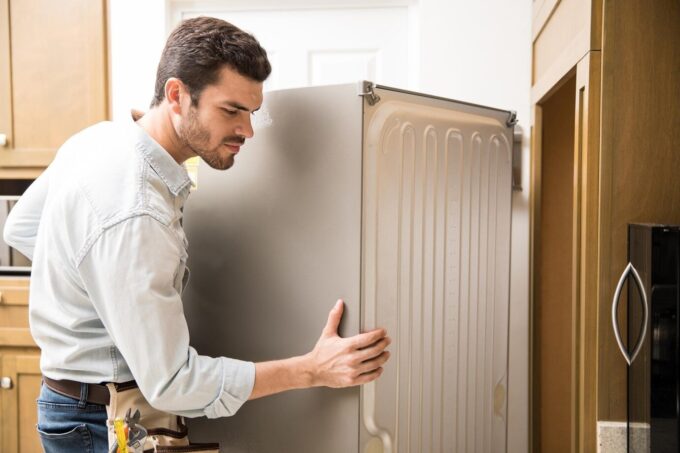When your refrigerator stops cooling, it’s not just inconvenient; it can lead to spoiled food and stress. The issue can range from minor to major, but the key is addressing it quickly to prevent further problems.
Sometimes, you may find it challenging to identify the exact issue. In cases where you’ve checked everything but the fridge still won’t cool, it’s time to contact a technician. For residents in Arizona, consider refrigerator repair Tucson services for fast and effective solutions. They will diagnose the issue, offer a repair plan, and get your fridge back in working order.
Let’s go straight to the causes and solutions that can help restore your appliance’s function.
Key Points
- Check the power source first.
- Look for any issues with the thermostat settings.
- Ensure the vents are clear for proper airflow.
- Inspect the door seals for leaks.
- Examine the condenser coils for dust or debris.
- Investigate the evaporator fan for malfunctions.
- Consider professional help if unsure.
1. Is It Plugged In?
Start with the basics. Is the refrigerator receiving power? An unplugged unit or a tripped breaker can easily go unnoticed. Look behind the appliance to see if the plug has come loose. Confirm that the power outlet works by plugging in another device.
Power issues are easy to fix. If the problem continues, though, you might be looking at something more serious.
2. Thermostat Setting Off

Source: freepik.com
Sometimes, the cooling issue can be linked to an incorrect thermostat setting. Maybe the temperature knob has been turned accidentally. Set the thermostat to the proper level and wait for a few hours to see if it cools down.
Don’t crank it all the way to the lowest setting in hopes of speeding up the process. The appliance will cool at its own pace. If there’s no improvement after a while, move to the next step.
3. Blocked Vents
The refrigerator needs free airflow inside to keep things cool. Vents located in the fridge and freezer need to be unobstructed. Check if large food items or containers block the vents. When airflow gets restricted, the cooling process slows down.
Once you’ve cleared the vents, give the appliance a few hours to adjust. A blocked vent can also cause a rise in temperature in the freezer section. So, don’t ignore this step.
4. Sealing Problems
Good door seals keep the cold air in and prevent warm air from entering. Over time, seals can wear out, tear, or develop gaps. Press on the seal and see if it sticks well. If it’s loose or cracked, you’ve found the culprit.
Replacing a seal can prevent larger repair needs. A weak seal makes the compressor work harder, which can lead to expensive fixes down the line.
5. Dirty Condenser Coils
The condenser coils, usually located at the back or beneath the refrigerator, need to stay clean. Dust and debris buildup on the coils can prevent efficient heat release. The more dust accumulates, the harder it is for the fridge to cool.
Use a vacuum or brush to clean the coils gently. Be careful not to damage them during the process. Cleaning should be done regularly to avoid any recurring issues.
6. Is the Evaporator Fan Running?
The evaporator fan is responsible for circulating cool air throughout the fridge and freezer compartments. If it’s not functioning, you’ll notice a lack of cooling. The fan usually stops when the door is open and resumes when it’s closed. If you suspect a malfunction, open the door, and press the door switch to check if the fan runs.
If the fan isn’t working, you might need a replacement. In some cases, an expert will be required for a proper fix.
7.Compressor Failure

Source: freepik.com
The compressor acts as the heart of the refrigerator. If it breaks, cooling stops entirely. Replacing a compressor is one of the most expensive fixes. If the refrigerator is older, you might want to consider if the repair cost is worth it.
A professional will need to inspect the compressor to determine the extent of the damage. In cases like this, the cost of the repair may be higher than getting a new appliance.
8. Frost Buildup
Frost in the freezer can hinder airflow. If frost buildup is excessive, you might have a defrost system issue. The defrost system consists of a defrost heater, thermostat, and timer. Any failure here can result in too much frost, preventing cool air from circulating.
You can defrost manually, but if the problem keeps recurring, it’s best to seek professional help. A technician will check for a more serious fault within the system.
9. Start Relay Issues
The start relay helps the compressor function properly. When it fails, the compressor cannot start, and the refrigerator will stop cooling. Listen for a clicking sound when the compressor tries to kick on. If you hear it and the refrigerator isn’t cooling, the relay might be the issue.
Swapping out the start relay is a relatively simple job for a professional. Replacing this component can save you from having to deal with more expensive repairs later on.
10. Control Board Malfunction
In modern refrigerators, the control board manages various functions, including cooling. When the board malfunctions, it can result in poor cooling or a total breakdown. Diagnosing a control board problem requires expertise.
A technician can replace a faulty control board. However, control board repairs can be on the pricier side. It’s important to weigh the cost before moving forward.
11. Water Line Leak

Source: freepik.com
Refrigerators with water dispensers or ice makers can experience cooling issues if the water line leaks. A small leak may not be immediately noticeable, but over time, it can lead to cooling problems. Check behind the appliance for any signs of water damage or leaks.
If you find a leak, shut off the water supply to the fridge and contact a professional. Water line issues need to be handled carefully to avoid further damage.
12. Refrigerant Leak
Refrigerant is the fluid responsible for cooling. A leak can significantly reduce the refrigerator’s cooling ability. A refrigerant leak usually requires professional intervention since it involves handling chemicals.
An expert technician will check the system for leaks and refill the refrigerant if necessary. This is one repair that should never be attempted without the right tools and knowledge.
Conclusion
Cooling issues with your refrigerator can arise for various reasons. From minor fixes like checking the door seals to more complex issues like compressor failure, it’s crucial to pinpoint the root cause as quickly as possible.
Simple issues can often be addressed at home, but professional help may be necessary for more complicated problems. Don’t let a malfunctioning refrigerator spoil your food and peace of mind—take action right away to fix the problem.







